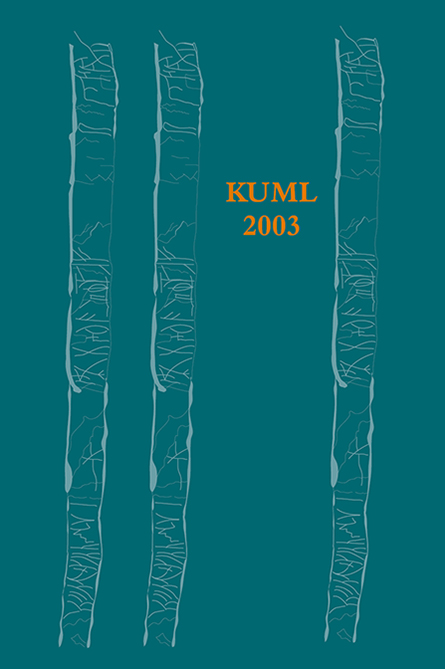Det Historiske Museum i Århus – gennem 100 år
DOI:
https://doi.org/10.7146/kuml.v52i52.102640Nøgleord:
Det Historiske Museum i ÅrhusResumé
The Historical Museum in ÅrhusThe Age of Enlightenment resulted in museums coming into existence all over Europe. Their purpose was to preserve exceptional items for posterity and to promote knowledge associated with these items. The museum idea fused with the national movements current at that time.
In Århus a Society of History and Antiquities was formed in 1861. The purpose of the society was to promote knowledge of antiquities by creating a collection, and to inform the public about the past through presentations and lectures. The society was led by an honorary committee which was in charge of the scholarly work. The collection was housed in the town hall (fig. 3).
Over the years, the museum experienced fluctuations in its development as different people influenced its work. In the beginning, the cause met great support, but public interest was lost during the war with Germany in 1864, and interest was not re-established until later. The greatest scholarly authority of the museum, Edvard Erslev, left town, and others took over (fig. 2).
Around 1870, the museum thrived again under the strong influence of Vilhelm Boye, a former employee of the Old Nordic Museum in Copenhagen, who was able to impart great scholarly expertise to the Århus museum. When he moved away from the town, the museum languished again. Around this time, a large new museum was built. However, most of its space was taken up by the art collection, whereas the historical collection was limited to a box-room-like area in the attic (figs. 5 and 10).
Christian Kjær, a lawyer, came to the rescue. Although engaged in many other forms of business, he managed to make a constructive contribution to the running of the museum (fig. 6). He maintained good relations with the Old Nordic Museum – or the National Museum as it had been renamed – and he succeeded in raising a considerable government grant for a planned extension to the museum (fig. 7). At the same time, the society was changed into an independent institution under the supervision of the National Museum. The name was changed into The Historical Department of Århus Museum.
The scholarly work now secured higher priority, and the museum began to undertake archaeological excavations on a larger scale. The next persons to represent the museum were Captain Smith (fig. 8) and lawyer Reeh, who were both recognised for their professional skills.
By the early 1900s, the museum faced a dilemma: the funds were insufficient for working with anything but prehistory, but interest in recent cultural history had grown, and the need to include this in the museum work was pressing. The result was that P. Holm (fig. 12) left the museum committee to found ´Den Gamle By, Danmarks Købstadsmuseum´ (The Old Town, Denmark’s Municipal Town Museum). In the 1920s the two museums began to cooperate, and the historical museum deposited its collections from the Middle Ages and later times in ‘Den Gamle By’. Now the Historical Department of Århus Museum consisted of a prehistoric collection and a coin collection. Librarian Eiler Haugsted (fig. 13) headed the museum and improved the exhibition of the reduced collections.
Everyone agreed that the museum and the university would benefit from closer cooperation. The extensive collection of plaster casts of antique works of art was moved to the university’s Department of Classical Archaeology and became the nucleus of its study collection. This resulted in much better space in the museum building. P. V. Glob was appointed Professor of Prehistoric Archaeology and leader of the museum. The engagement of a permanently employed, skilled leader resulted in marked changes in the museum, which now concentrated on Prehistoric Archaeology and Ethnography and soon achieved a special position within these fields. Within a few years – from being a museum run almost completely by volunteers – the museum had developed into a big institution with a large, professional staff.
Jens Skriver
Moesgård Museum
Translated by Annette Lerche Trolle
Downloads
Publiceret
2003-12-14
Citation/Eksport
Skriver, J. B. (2003). Det Historiske Museum i Århus – gennem 100 år. Kuml, 52(52), 81–123. https://doi.org/10.7146/kuml.v52i52.102640
Nummer
Sektion
Artikler
Licens
Fra og med årgang 2022 er artikler udgivet i Kuml med en licens fra Creative Commons (CC BY-NC-SA 4.0).
Alle tidligere årgange af tidsskriftet er ikke udgivet med en licens fra Creative Commons.


